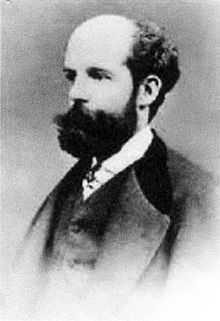Georges Leclanché
Georges Leclanché (born October 9, 1839 in Parmain , Département Seine-et-Oise , † September 14, 1882 in Paris ) was a French physical chemist .
George Leclanché began his studies in England, but returned to France to enter the École Centrale des Arts et Manufactures (now École Centrale Paris ), where he graduated in 1860.
Georges Leclanché invented the Leclanché element , which is considered the forerunner of today's dry batteries and which he patented in 1866. Leclanché received a bronze medal at the world exhibition in Paris that same year. The battery was immediately introduced by the Belgian railways and the Belgian telegraph. Leclanché continuously improved the battery and in 1876 he was able to turn the electrolyte into a gel by adding starch.
In the meantime he had moved to Paris, where he married Gabrielle Clementine-Lannes in 1873 and had two children.
The improved version of the Leclanché element consists of a zinc beaker filled with an ammonium chloride solution thickened with gelatine . A carbon electrode, which is coated with powdered brownstone , dips into this cup .
literature
- K. Jäger, F. Heilbronner (ed.): Lexikon der Elektrotechniker , VDE Verlag, 2nd edition from 2010, Berlin / Offenbach, ISBN 978-3-8007-2903-6 , p. 259
Individual evidence
- ↑ a b c d e Kevin Desmond: Innovators in Battery Technology Profiles of 95 Influential Electrochemists . McFarland, 2016, ISBN 978-1-4766-2278-1 , pp. 132 ( limited preview in Google Book search).
- ↑ Georges Leclanché: French Patent No. 71 865, granted in 1866
- ^ Lance Day, Ian McNeil: Biographical Dictionary of the History of Technology . Routledge, 2002, ISBN 978-1-134-65020-0 , pp. 733 ( limited preview in Google Book search).
| personal data | |
|---|---|
| SURNAME | Leclanché, Georges |
| BRIEF DESCRIPTION | French physical chemist |
| DATE OF BIRTH | October 9, 1839 |
| PLACE OF BIRTH | Parmain , Seine-et-Oise department , France |
| DATE OF DEATH | September 14, 1882 |
| Place of death | Paris , France |
